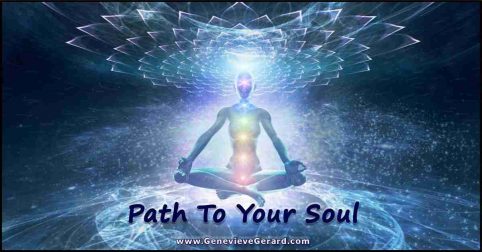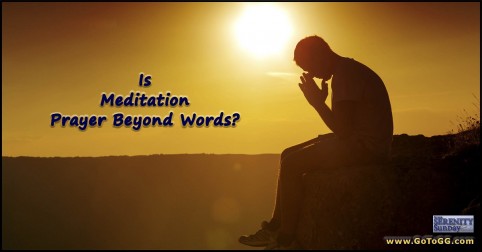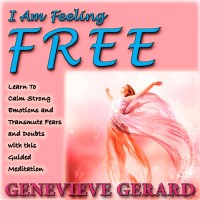
Mindfulness and
Meditations For Daily Joy
-Taking Mindfulness
to the Soul Level
by Douglas Russell, M.S.W.
Mindfulness meditation and Genevieve Gerard’s work have a lot in common. I know this from personal experience. I began meditating regularly in the late 1960’s. At the time, I was studying spiritual philosophies and transpersonal psychology. I was also learning traditional psychotherapy in graduate school. My meditation practice began with the same steps presented in the Meditations for Daily Joy: first getting centered by relaxing my body and calming my feelings and thoughts, then opening my heart and visualizing a brilliant point of light over my head as a symbol of my soul. I was learning that variations of these techniques had been passed down through generations of spiritual teachers in the East over thousands of years.
When I started exploring mindfulness in the 1990’s, it was also described as evolving from those ancient Eastern traditions, but it wasn’t connected directly to spirituality or the soul. It was popularized in the U.S. through the Mindfulness-Based Stress Reduction Program at the University of Massachusetts, founded by a man with a Ph.D. in molecular biology, Jon Kabat-Zinn. The basic technique is to sit or lie down, and simply pay attention to your breath or your body sensations. Anytime the mind starts to wander, bring it back over and over to these sensations in the present moment: breathing awareness, and the five senses.
Over the past 30 years, mindfulness has proved to be very effective–not only for stress management, but for coping with chronic pain, depression and addiction, and for improving relationships. In medicine and psychology, mindfulness is still presented as secular: it works just as well for people who are not religious as for those who have strong spiritual beliefs. It seems so different from Touch of the Soul, which is clearly the work of a spiritual teacher who has combined a variety of techniques to guide people toward the experience of higher consciousness. Let’s look at what mindfulness is, then I’ll describe how mindfulness and Touch of the Soul meet and blend so well, as Genevieve Gerard takes us beyond today’s mindfulness practices into the experience of spirituality.
Mindfulness has been explored in great detail by researchers, physicians, psychologists, and religious leaders. Through the myriad of workshops, writings, CD’s, DVD’s and websites, four basic aspects of mindfulness meditation come up over and over again:
1. Being in the present moment. Often our body is in one place but our mind is somewhere else: we’re thinking about the past (would-a, could-a, should-a), concerned about the future, or wanting things to be different from the way they are. But the body can’t travel to the past or future: it’s living only in the present. When you are mindful of your breathing, or what you are seeing or hearing, your attention shifts from your thoughts to your immediate experience. It is only when you are fully aware in the here and now, that you truly experience your life.
2. Doing one thing at a time and knowing that you’re doing it. Modern life often requires that we think, plan, and move rapidly among many activities. There’s nothing wrong with multi-tasking, but it’s not mindfulness. To be mindful is to take a break from all that movement of body and mind, and focus on just one thing–like the sensations in your feet while walking, or experiencing the pleasure of taking one bite of your favorite food while giving your full attention to smelling, tasting and chewing it.
3. Using in-tention to focus at-tention. If your intention is to sit down and enjoy a good meal, your best chance at success is to keep your attention on eating without the distraction of watching TV or reading or constant conversation. Mindfulness involves learning to stay with your intention: you choose to focus on breathing, and every time you notice your attention has moved to something else, you gently return your focus to breathing awareness. During meditation the mind will surely wander. Your body might capture your attention with feelings of fatigue or pain. Sounds in the environment might disturb your concentration. Any number of things could take your attention away from your breathing; but to be mindful is to stay with your purpose regardless of any such distractions. People from all walks of life find that mindfulness meditation helps with productivity and achieving goals. It’s training yourself to stay focused on what you’re intending to do.
4. Practicing meditation regularly. Mindfulness is a skill that improves with consistent practice. The direct experience and insights this meditation provides are called wisdom-based learning, as contrasted with fact-based learning that comes from a teacher or a book. Taking classes or reading about meditation is useful, but it isn’t mindfulness. When you have practiced day-after-day, returning to a calm center of awareness every time there’s a distraction, eventually you can hold onto that state of mind even when facing life’s trials and tribulations. Beginners in meditation may sense a calm and centered state of consciousness only for brief moments, but with continued practice it becomes a habit, a way of life. In mindfulness terms, “states become traits.”
Genevieve Gerard’s teachings on transformational consciousness point toward many levels of mindful awareness and beyond. She sees centering as a stepping stone to higher states of mind which eventually lead to being in touch with your soul and living a life full of love, creativity and joy.”
– Doug Russell
The many facets of mindfulness boil down to this: centering comes about by paying attention to the body and the five senses rather than getting caught up in negative thinking or worrying. We can learn to experience life’s challenges and hardships from a center of calm and kindly awareness. Genevieve Gerard’s teachings on transformational consciousness point toward many levels of mindful awareness and beyond. She sees centering as a stepping stone to higher states of mind which eventually lead to being in touch with your soul and living a life full of love, creativity and joy. Her methods include affirmations–focusing on carefully-chosen positive words and thoughts–plus sensory awareness, and use of the creative imagination, visualizing images, symbols, colors, and energy flows.
Here’s how I see the four basic aspects of mindfulness in light of
Genevieve Gerard’s teachings:
1. In the present moment, I know that I am between heaven and earth,
and I am not alone.
Prepare to meditate by focusing on breathing awareness and inviting your body to relax. You surrender your weight to the pull of gravity, acknowledging that you are being supported by the earth. Continue this move into your centered self by inviting your mind to become calm and your heart to open. As this inner observer you can affirm that you are more than any particular body sensation or feeling or thought that you have. You then sense or imagine your higher self as a point of light above your head shining like the sun. This whole process is an acknowledgment that your life in the here and now exists literally between heaven and earth. You are opening your mind to the recognition that you are much more than your earthly existence–that you are a spiritual being.
The next step in meditation could involve focusing your attention on positive thoughts and energies, or on the highest human qualities such as forgiveness or love. In reality, such qualities are often experienced in relationship to others. Your daily life involves contacts with people close to you and with strangers. Even if you are meditating alone, you know that in the here and now, there are many other people going about their lives as you focus on yours. Any meditation technique that promotes personal well-being can be extended for the well-being of others. Start with “joy to myself;” proceed with “joy to the world.” As you continue this practice, you will notice the rising quality of your relationships and the sense of being connected to all of life.
2. My mind can sense and know many things at one time.
Mindfulness emphasizes the physical senses for experiencing the here and now, but there is an acknowledgment of the mind as a sixth sense. The brain interprets what our eyes and ears register in the physical world, while the mind has its own perceptions that are meta-physical. It may be true that the verbal concrete mind does one thing at a time, like looking at a rainbow and naming each color, deliberately focusing your eyes on one color, then the next and the next. But suppose you center yourself, and look at the rainbow as a whole, softening your eyes, perceiving all the colors at once, without labeling them. This is an example of using the abstract mind–the perspective of higher consciousness.
Genevieve Gerard shows us how we can learn through meditation to apply this broader perspective in everyday life. Suppose you go for a walk and as you take a single step you pay attention to the sensation of your foot touching the ground, then build awareness: also notice that you are breathing in, that you are seeing the beautiful colors of flowers, and you are exchanging warm greetings with people you walk by. Suppose you start to eat an egg, and as you bring that first bite toward your mouth, seeing and smelling it, feeling your mouth watering, you pause to reflect on this moment as the culmination of the past, and containing seeds of the future. The egg came from a chicken, was gathered and packaged by ranch hands, taken to market by a truck driver, and placed on display and sold by workers in the market before you bought it and brought it home. After you eat it, it will provide your body the energy it needs as you move through the rest of your day.
3. My intention is to focus on the images, qualities, and thoughts that are pathways to higher consciousness.
As you continue to develop your meditation skills, you can expand the scope and variety of your intentions. To some degree, the chattering mind will continue to disturb your concentration, but you will eventually find that you can return to center more quickly and easily than you could at the beginning. In effect, you’re developing your will, your power of choice. As you choose to give more attention to the image of the radiant light above your head, that alone engenders some of the highest qualities. It’s like sitting in the sunlight on a pleasant day. The sun’s warmth brings a feeling of being nurtured and loved. The sun’s light brings a sense of mental clarity and light-heartedness. It is the opposite of darkness, which symbolizes ignorance, depression or fear.
Subjects for meditation besides the breath could be a single word, a positive phrase or sentence, or a sequence of several steps. A meditation on the word “gratitude” is like holding a precious stone in your hand, looking carefully at all its various facets. You may begin to feel gratitude for each of your loved ones, for anything in your life that you enjoy, for your accomplishments, for the daily moments of noticing that which is good, beautiful, or fulfilling. Expand this idea by meditating on a phrase or sentence from the Affirmations for Abundance, which are positive thoughts that can bring your mind and your life into states of inspiration, celebration, joy, prosperity. Or meditate on a series of steps, beginning with “calm your mind, open your heart, invite the light;” continue by lighting a candle, and as it dispels darkness, hold the thought of faith and hope dispelling fear; then as you get a sense of transcending your own fear, imagine that each moment you focus on the light, it is building and multiplying, and helping to ignite hope for everyone, making the world a better place.
In Genevieve Gerard’s articles and the Meditations for Daily Joy CD’s, you’ll find many examples of going through a set series of steps, on themes ranging from dealing with negative emotions or challenging relationships, to building a broader perspective on everyday experiences like eating, bathing, taking a walk, or traveling. The principle involved here is that energy follows thought: through regular focus on any positive human quality, it eventually becomes a trait–a way of looking at life, a way of experiencing your life that is available throughout each and every day.
4. As I meditate regularly, my soul becomes more familiar to me,
as a part of who I truly am.
The soul is our higher self, that aspect of our identity which has all the highest and best qualities of human nature: unconditional love, wisdom, goodwill, creativity, joy. The soul has a perspective that includes our personal concerns or needs yet goes beyond them. There is a recognition of being part of the larger whole–a sense of the interdependence with other human beings and with all of life. There is a sense that any problems or concerns of the moment can be seen in a new light, free of fear, anxiety or depression.
Among the symbols of the soul to meditate upon are: that brilliant point of light above the head, a wise spiritual guide or master, or an angel. Besides focusing on these during a formal sitting meditation, we can return to these images anytime during the day while involved in other activities. In mindfulness this is called informal practice. In Touch of the Soul work, this is developing a “dual consciousness.” It is applying the principle that energy follows thought. Along with the full awareness of activities and relationships in the physical world, there can be a constant sense of the perspective and influence of the soul–the sense that at each moment, you are a spiritual being, living in the light, with access to the qualities of a higher purpose, love, wisdom, and creativity. Your soul becomes your constant companion on your journey through life.
About the Author: Douglas Russell, M.S.W. has studied esotericism and practiced occult meditation for over 40 years. As a psychotherapist, trainer of healthcare professionals, medical social worker and writer, he specialized in psychosynthesis–a psychology of personal and spiritual growth that combines traditional counseling methods with guided imagery, visualization and meditation. He has been exploring mindfulness practices for over ten years.
About Genevieve Gerard: Genevieve Gerard teaches Transformational Consciousness – from first awakening to enlightened awareness. She helps you experience the joy that results from the spontaneous “touch of the soul.” Browse her body of work at www.GenevieveGerard.com. Copyright © 2012 by Genevieve Gerard. All rights reserved.
Please feel free to pass this article on to others who may find it of interest. You may reprint the article by following the Permission to Reprint information below.
Permission to Reprint
You are allowed to reprint articles published by Touch of the Soul, as long as proper credit and citation is given. To reprint an article, you must credit the author, indicate the original date of publication on Genevieve Gerard’s website, and include the appropriate reprint permission language. Content reproduced from Touch of the Soul may not be edited, but you may use excerpts. When reprinting content, you must always include this reprint permission language at the end of the article. If the content will be reprinted on your Web site or blog, you must include a live (search engine followed) link to
Genevieve Gerard’s website and the original article
Mindfulness and Meditations For Daily Joy.
Reprint Permission Language: Reprinted from Touch of the Soul with permission from Doug Russell, author of ‘Mindfulness and Meditations For Daily Joy’ 06-24-2012. All rights reserved.
Linking Information:
Genevieve Gerard –
http://www.GenevieveGerard.com
Mindfulness and Meditations For Daily Joy –
http://www.GenevieveGerard.com/articles/mindfulness











